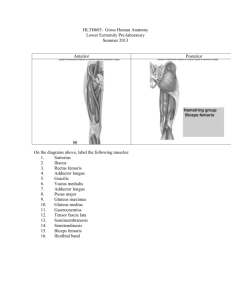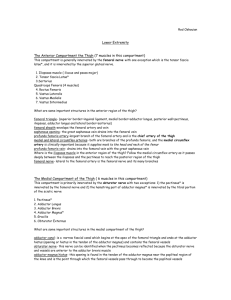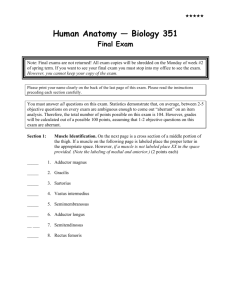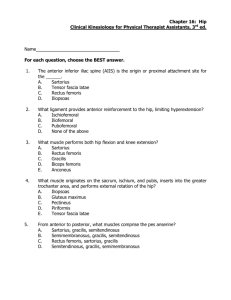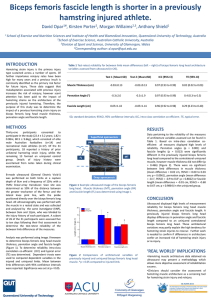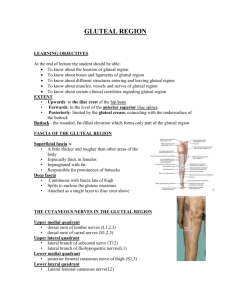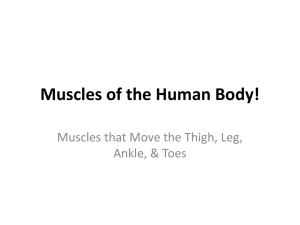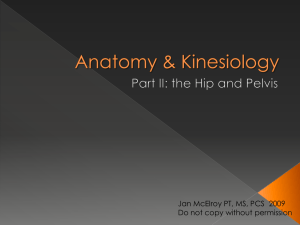The Canine Muscle Atlas Project - Interactive Canine Pelvic Limb
advertisement
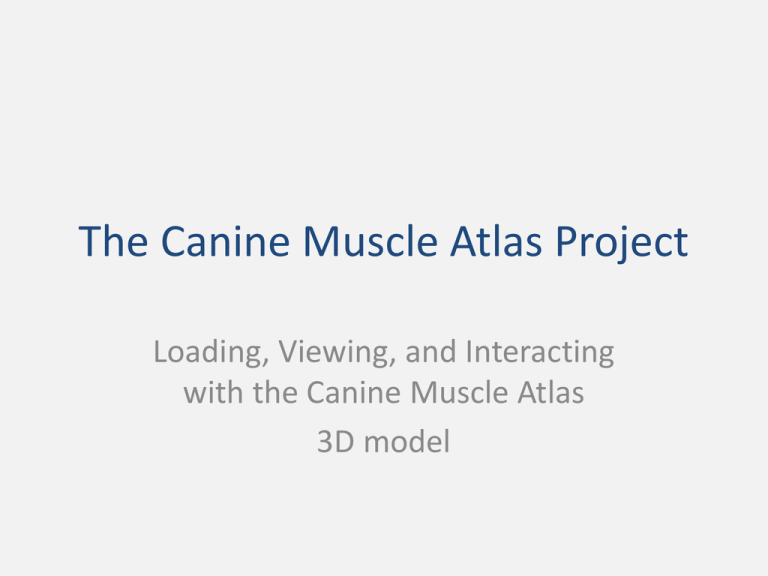
The Canine Muscle Atlas Project Loading, Viewing, and Interacting with the Canine Muscle Atlas 3D model Getting started • Download the MuscleAtlas3Dmodel.zip file. – Extract all files and note where they are saved • Download and install the latest stable release of 3D Slicer from: http://slicer.org/pages/Special:SlicerDownloads – 3D Slicer is large and the download time will depend on the connectivity method – Open the 3D Slicer program Click “File” and select “Load Scene” Find the folder containing the files that you downloaded and unzipped. Open the CanineMuscleAtlas.mrml file (ignore the _CanineMuscle.mrml file) The skeletal model should automatically display with the right limb muscles displayed; this may take a few minutes Reorienting the model To move the model in real time, click on the 3D display window and drag the mouse Clicking on the axis labels will result in standardized orthogonal views To move the model incrementally, click on these buttons with the to change the pitch, roll, or yaw Changing the display window To change the background color, hide the 3D cube or hide the 3D axis labels, select the pop-ups activated by clicking the eye. Changing the structures on display Click on the stack of cameras to select muscles grouped by function (e.g. stifle extensors) or muscles grouped by innervation (e.g. by femoral nerve). There will be a delay when changing between scenes. The “Stifle_extensors” snapshot Muscles in this group are indicated by an “open” eye in the MRML tree. Selective display Although the snapshots provide rapid display of preset groups, the user is able to tailor the 3D model to display individual muscles. Choose the “Skeleton 1” snapshot to display the 3D bone model. Then click on any “closed eye” in the MRML tree to display that muscle. See blue arrow above. See next slide. Selective display For example, by checking the eye next to the quadriceps femoris muscle, it will be displayed on the skeleton. User interface display options By clicking on the blue button, you can change the layout of the user interface window, to simultaneously display the segmented MR images. User interface display options Or display only a single panel of images… Label identification Easy muscle identification is one advantage of displaying the segmented MR images. Placing the mouse over a colorblock segmentation results in the muscle identification appearing in the lower left of the image (see arrow). This can be done with in the 4 panel display, or in the a single panel display Cursor Muscle Label identification Cursor Muscle More to know… • Slicer is an incredibly powerful program with diverse capabilities. In this tutorial only the most basic functions have been explained. • For more information on the capabilities of 3D Slicer, see the following website: http://www.slicer.org/slicerWiki/index.php/Tr aining Appendix In creating the 3D model snapshots, the pelvic limb musculature was categorized by function, and by innervation. The following lists provide the individual muscles included in each grouping. Muscles categorized by function Hip supination • • • • Iliopsoas Internal obturator Quadratus femoris External obturator Hip abduction • • • • • Superficial gluteal Middle gluteal Piriformis Deep gluteal Abductor cruris caudalis Hip adduction • • • • Gracilis Pectineus Adductor magnus and brevis Adductor longus Hip flexion • • • • • Iliopsoas Tensor fasciae latae Rectus femoris (quadriceps femoris) Articularis coxae Sartorius Hip extension • • • • • • • • • • Superficial gluteal Middle gluteal Deep gluteal Piriformis Quadratus femoris Biceps femoris Semitendinosus Semimembranosus (stance phase) Adductor longus Adductor magnus et brevis Stifle flexion • • • • • • • Biceps femoris (non-weight bearing) Abductor cruris caudalis Semitendinosus Semimembranosus (non-weight bearing) Sartorius (caudal part) Gastrocnemius Superficial digital flexor Stifle extension • • • • • • Tensor fasciae latae Biceps femoris (stance phase) Semimembranosus (stance phase) Quadriceps femoris Articularis genus Sartorius (cranial part) Resists supination of the limb • Popliteus Tarsal flexion • Cranial tibial • Long digital extensor • Peroneus (fibularis) longus Tarsal extension • • • • • • • • Biceps femoris Semitendinosus Semimembranosus (stance) Gracilis Gastrocnemius Superficial digital flexor Deep digital flexor Caudal tibial Digital flexion • Superficial digital flexor • Deep digital flexor (medial and lateral heads) Digital extension • Long digital extensor • Lateral digital extensor Pronation of the pes • Peroneus (fibularis) longus Supination of the pes • Cranial tibial Muscles categorized by innervation Femoral nerve † (L4-L6) • Quadriceps femoris • Articularis coxae • Sartorius (occas saphenous n., a br. of femoral n.) † forms within the body of the iliopsoas m. Obturator Nerve (L4-L6) • • • • • Gracilis Pectineus Adductor magnus et brevis Adductor longus External obturator Gluteal nerves (lumbosacral trunk) • Cranial gluteal nerve (L6-S1) – Deep gluteal – Middle gluteal – Tensor fasciae latae – Piriformis1 • Caudal gluteal nerve (L7, occas S1-S2) – Superficial gluteal – Piriformis2 Sciatic nerve (L6-S1) • • • • • • • Internal obturator Gemelli Quadratus femoris Biceps femoris Semitendinosus Semimembranosus Abductor cruris caudalis Common & deep peroneal nerves (L6-7) br. of sciatic nerve • Peroneus(fibularis) longus (common and deep peroneal nn.) • Peroneus(fibularis) longus (deep peroneal n) • Cranial tibial (deep peroneal n.) • Long digital extensor (deep peroneal n.) Tibial nerve (L6-S1) larger br. of sciatic nerve • • • • • Gastrocnemius Superficial digital flexor Deep digital flexor Caudal tibial Popliteus References 1. Evans HE, deLahunta A. Guide to the Dissection of the Dog. 7th ed. St. Louis: W. B. Saunders; 2010. 2. Evans HE. Miller's anatomy of the dog. 3rd ed. Philadelphia: W. B. Saunders Co.; 1993. 3. Done SH, Goody PD, Evans SA, Stickland NC. Color atlas of veterinary anatomy, volume 3. New York: Mosby; 1996. 4. Smallwood JE, George TF. Anatomic atlas for computed tomography in the mesaticephalic dog: abdomen and pelvis. Vet Radiol Ultrasound 1992;33:147-167. 5. Yushkevich PA, Piven J, Hazlett HC, Smith RG, Ho S, Gee JC, and Gerig G. User-guided 3D active contour segmentation of anatomical structures: Significantly improved efficiency and reliability. Neuroimage 2006 Jul 1;31(3):1116-28.
